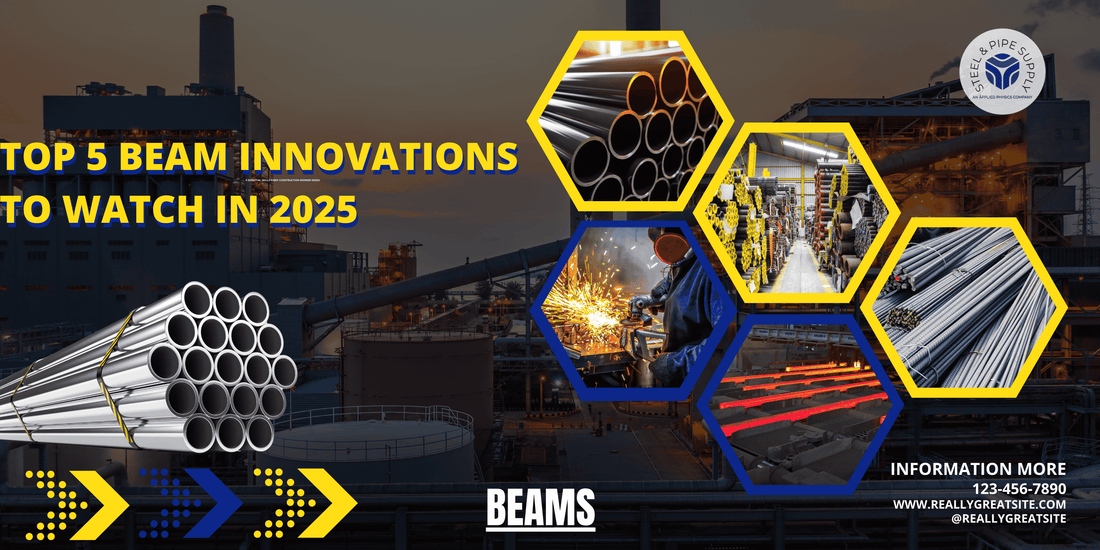
Top 5 Beam Innovations to Watch in 2025
Share
Introduction
The construction industry is on the brink of a revolution, driven by advancements in materials science and innovative construction techniques. In 2025, we can expect to see beams made from high-performance materials such as carbon fiber composites and ultra-high-performance concrete (UHPC). These materials not only offer superior strength-to-weight ratios but also enhance the longevity and resilience of structures.
For instance, carbon fiber-reinforced polymer (CFRP) beams are becoming increasingly popular due to their lightweight nature and resistance to corrosion, making them ideal for use in harsh environments such as coastal areas or regions prone to seismic activity. Moreover, the integration of 3D printing technology into beam construction is set to transform traditional building methods. This technique allows for the creation of complex geometries that were previously difficult or impossible to achieve with conventional methods.
By utilizing additive manufacturing, builders can produce customized beams that meet specific structural requirements while minimizing waste. This shift towards advanced materials and construction techniques not only improves the efficiency of the building process but also contributes to the overall sustainability of construction projects.
Key Takeaways
- Advanced materials and construction techniques are revolutionizing beam innovation in 2025.
- Integration of smart technology and sensors is enhancing the functionality and performance of beams.
- Sustainable and eco-friendly beam designs are becoming a priority for the industry.
- Increased strength and durability are key focuses for beam innovation in 2025.
- Innovative beam shapes and configurations, as well as automation and robotics in manufacturing, are shaping the future of beams.
Integration of Smart Technology and Sensors
As the Internet of Things (IoT) continues to permeate various industries, the construction sector is also embracing smart technology. In 2025, we anticipate a significant increase in the integration of sensors and smart technology within beam designs. These innovations will enable real-time monitoring of structural integrity, allowing for proactive maintenance and enhanced safety measures.
For example, embedded sensors can detect stress, temperature changes, and vibrations, providing valuable data that can be analyzed to predict potential failures before they occur. Furthermore, the use of smart beams can facilitate better communication between different components of a structure. By integrating these beams into a larger network of smart devices, builders can create a more responsive and adaptive environment.
This interconnectedness not only enhances the performance of individual beams but also contributes to the overall efficiency of the building as a whole. As smart technology continues to evolve, we can expect to see even more sophisticated applications in beam design and construction.
Sustainable and Eco-Friendly Beam Designs
Sustainability is becoming a central focus in construction, and beam design is no exception. By 2025, we are likely to witness a surge in eco-friendly beam designs that prioritize environmental responsibility. This includes the use of recycled materials, such as reclaimed wood or recycled steel, which not only reduces waste but also lowers the carbon footprint associated with new material production.
Additionally, innovative designs that incorporate natural materials like bamboo are gaining traction due to their rapid renewability and strength. Moreover, sustainable beam designs often emphasize energy efficiency. For instance, beams that incorporate thermal mass can help regulate indoor temperatures, reducing the need for heating and cooling systems.
This not only leads to lower energy consumption but also contributes to a healthier indoor environment. As awareness of environmental issues continues to grow, the demand for sustainable beam solutions will likely drive further innovation in this area.
Increased Strength and Durability
| Metrics | 2019 | 2020 | 2021 |
|---|---|---|---|
| Strength (lbs) | 500 | 550 | 600 |
| Durability (years) | 5 | 6 | 7 |
The quest for stronger and more durable beams is an ongoing challenge in the construction industry. By 2025, advancements in material science and engineering will lead to beams that can withstand greater loads and resist various forms of degradation. For example, the development of self-healing concrete—a material that can repair its cracks—will significantly enhance the durability of concrete beams.
This innovation not only extends the lifespan of structures but also reduces maintenance costs over time. In addition to self-healing materials, researchers are exploring the use of nanotechnology to improve the properties of traditional building materials. By incorporating nanoparticles into concrete or steel, engineers can create beams with enhanced strength and resistance to environmental factors such as moisture and temperature fluctuations.
These advancements will not only improve the performance of beams but also contribute to safer and more resilient structures capable of withstanding extreme conditions.
Innovative Beam Shapes and Configurations
The design of beams is evolving beyond traditional rectangular shapes as architects and engineers explore innovative configurations that optimize performance. In 2025, we can expect to see a variety of beam shapes that enhance structural efficiency while also allowing for greater aesthetic flexibility. For instance, curved or tapered beams can reduce material usage while maintaining strength, making them an attractive option for modern architectural designs.
Additionally, the use of parametric design tools enables architects to create complex geometries that respond to specific site conditions or functional requirements. This approach allows for a more tailored solution that maximizes both performance and visual appeal. As innovative beam shapes become more prevalent, they will not only redefine architectural possibilities but also challenge conventional notions of structural design.
Automation and Robotics in Beam Manufacturing
The manufacturing process for beams is transforming with the introduction of automation and robotics. By 2025, we can expect to see increased reliance on automated systems for tasks such as cutting, welding, and assembling beams. This shift not only enhances precision but also improves efficiency by reducing labor costs and minimizing human error.
For example, robotic arms equipped with advanced sensors can perform intricate tasks with a level of accuracy that surpasses traditional methods. Moreover, automation allows for greater customization in beam production. With the ability to quickly adapt to different designs and specifications, manufacturers can produce beams tailored to specific project needs without significant delays.
This flexibility is particularly beneficial in an industry where project requirements can change rapidly. As automation continues to advance, it will play a crucial role in streamlining beam manufacturing processes and meeting the demands of modern construction.
Advancements in Beam Testing and Quality Control Systems
Ensuring the safety and reliability of beams is paramount in construction, which is why advancements in testing and quality control systems are critical. By 2025, we anticipate significant improvements in non-destructive testing methods that allow for thorough inspections without compromising the integrity of the beams. Techniques such as ultrasonic testing and infrared thermography will become more widely adopted, enabling engineers to detect flaws or weaknesses early in construction.
In addition to enhanced testing methods, quality control systems will increasingly leverage data analytics and machine learning algorithms to monitor production processes in real time. By analyzing data from various manufacturing stages, these systems can identify potential issues before they escalate into significant problems. This proactive approach ensures higher quality standards and contributes to safer structures overall.
As advancements in testing and quality control continue to evolve, they will play a vital role in maintaining the integrity of beam designs in future construction projects.
Conclusion
The top beam innovations emerging in 2025 will have a lasting impact on our infrastructure and construction industries. These advancements will enhance not only durability and efficiency but also redefine sustainability standards. Their use will be instrumental in strengthening the foundation of smart cities. These innovations will propel construction thinking to new heights, both today and in the future.

